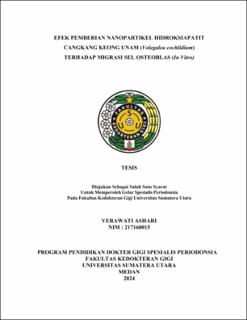| dc.description.abstract | Background: Periodontitis is a multifactorial disease in the oral cavity caused by
specific microorganisms and can cause progressive damage to the periodontal ligament
and alveolar bone. Treatment to restore the structure and function of periodontal tissue
in alveolar bone damage is by administering bone graft material. Hydroxyapatite is an
inorganic component whose chemical and mineral structure is similar to bones and
teeth that are widely found in nature such as fish scales, egg shells, snail shells and
coral. Unam snails (Volegalea cochlidium) are a group of gastropods that have hard
shells with high calcium carbonate content and can be used as a source of calcium in
the synthesis of hydroxyapatite. Objective: To analyze the effect of administering
hydroxyapatite nanoparticles from unam snail shells (Volegalea cochlidium) on
osteoblas cell migration in vitro. Materials and Methods: Hydroxyapatite
nanoparticles from unam snail shells were made using a combination of mechanicalchemical
methods, namely ball mill and sol gel. Osteoblas cells were obtained from
mouse calvaria cultured in α-MEM media. Osteoblas cell migration test was conducted
using the scratch method and repeated 3 times. The distance of the scratch wound was
observed and snapshot images were taken with an inverted mirror at several time
intervals (24, 48 and 72 hours), data were analyzed using One-way ANOVA and Post
Hoc LSD. Results: There was a significant difference in the effectiveness of
hydroxyapatite nanoparticles from the unam snail shell (Volegalea cochlidium) in all
treatment groups with the control group on osteoblas cell migration at observation
times of 24, 48 and 72 hours, with the highest average percentage at observation time
of 24 hours found in the treatment group with a concentration of 0.39 mg/mL (98.81%),
48 hours at a concentration of 0.78 mg/mL and 0.39 mg/mL (100%) and 72 hours at a
concentration of 12.5 mg/mL, 6.25 mg/mL, 3.125 mg/mL, 1.56 mg/mL, 0.78 mg/mL
and 0.39 mg/mL (100%). Conclusion: low concentration of hydroxyapatite
nanoparticles from the unam snail shell (Volegalea cochlidium) increase osteoblas cell
migration. | en_US |


